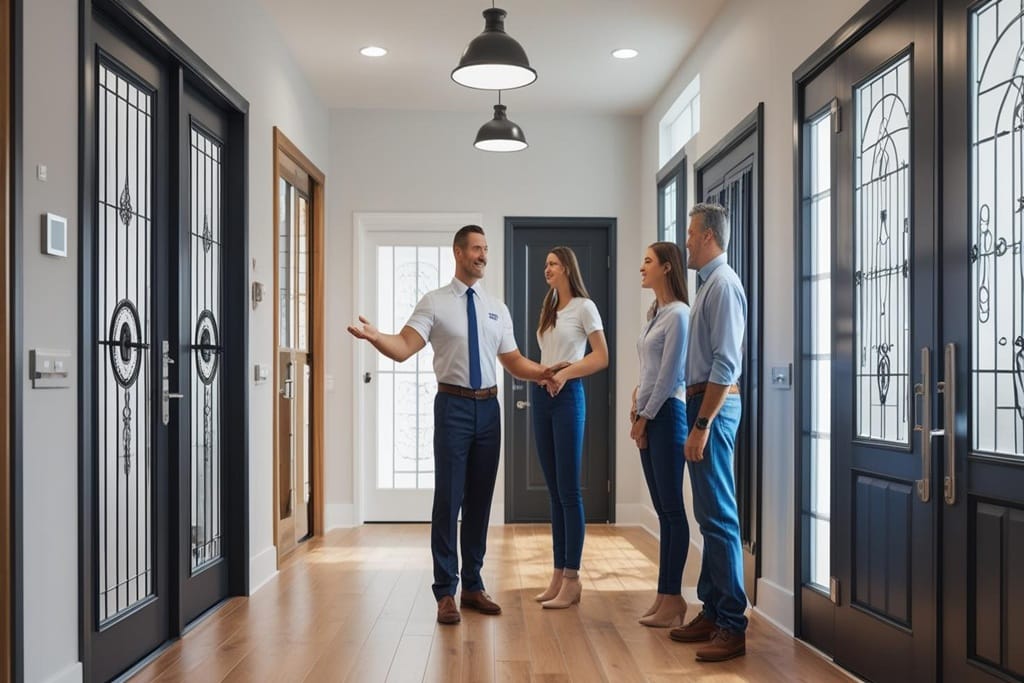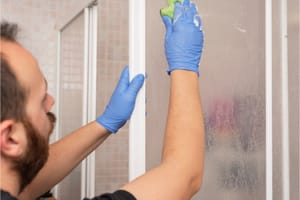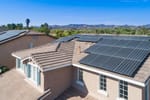Your front door serves as the first line of defense against intruders. Choosing a security door is one of the most important decisions for protecting your family and property.
With home break-ins occurring every 13 seconds in the United States, investing in a high-quality security door isn't just smart—it's essential.
A security door goes far beyond the basic function of a standard residential door.
While regular doors focus primarily on privacy and weather protection, security doors are engineered specifically to resist forced entry, withstand extreme weather conditions, and provide enhanced protection without sacrificing your home's aesthetic appeal.
Choosing the right security door can feel overwhelming with so many options available.
The key lies in understanding which features truly matter for your specific security needs and living situation.
We will walk you through seven critical features that separate effective security doors from basic alternatives, helping you make an informed decision that keeps your home safe for years to come.
1)) Material Quality And Construction
The foundation of any reliable security door lies in its materials and construction methods.
Steel remains the gold standard for security doors, offering superior strength and durability that can withstand significant force.
Look for doors constructed from heavy-gauge steel—typically 16-gauge or thicker—which provides excellent resistance against kicks, impacts, and prying attempts.
Aluminum security doors offer another excellent option, particularly for coastal areas where corrosion resistance is crucial.
While generally lighter than steel, high-quality aluminum doors with reinforced frames can provide substantial security benefits.
The key advantage of aluminum is its natural resistance to rust and corrosion, making it ideal for humid climates.
Some manufacturers now offer composite materials that blend steel reinforcement with other elements to create doors that are both strong and lightweight.
These hybrid options often provide better insulation properties than pure steel while maintaining excellent security characteristics.
Pay attention to how the door is constructed, not just what it's made from.
Quality security doors feature welded joints rather than bolted connections, eliminating weak points that could be exploited. The door should feel solid, with no flex or give when pressure is applied.
2)) Advanced Locking Mechanisms
The locking system represents the heart of your security door's protective capability.
Multi-point locking systems offer superior security by engaging locks at multiple points along the door frame simultaneously.
These systems typically secure the door at three to five different points, making it nearly impossible for intruders to force entry by attacking a single lock point.
Deadbolt locks should meet Grade 1 ANSI standards, which require them to withstand 250,000 open-close cycles and resist significant force applications.
Look for deadbolts with at least a one-inch throw that extends deep into the door frame.
The strike plate should be reinforced with long screws that penetrate the wall studs, not just the door frame.
Smart lock integration has become increasingly popular, allowing homeowners to monitor and control access remotely.
These systems can send alerts when someone attempts to tamper with the lock and provide detailed logs of who enters and exits your home.
However, ensure any smart lock system includes backup mechanical operation in case of power failures or technical issues.
Consider locks with anti-pick and anti-bump features, which protect against sophisticated entry techniques that criminals sometimes use.
Cylinder guards can prevent drill attacks on the lock mechanism, while reinforced lock boxes protect the entire locking assembly from tampering.
3)) Frame Reinforcement And Installation
Even the strongest security door becomes ineffective without proper frame reinforcement and installation.
The door frame must be able to withstand the same forces as the door itself, which means standard residential door frames often require significant upgrades.
Heavy-duty hinges rated for security applications should replace standard residential hinges.
Security hinges typically feature non-removable pins or continuous welded construction that prevents removal even if the pins are accessible from outside.
Look for hinges rated to support the additional weight of security doors, typically requiring four or more hinges instead of the standard three.
The strike plate area requires special attention, as this is where most forced entry attempts focus their energy.
Reinforced strike plates should extend at least 12 inches in length and attach to the wall framing with 3-inch screws.
Some security door systems include full-length reinforcement plates that run the entire height of the door frame.
Door frame reinforcement kits can strengthen existing frames, but new construction or major renovation projects should consider steel door frames designed specifically for security applications.
These frames distribute impact forces more effectively and eliminate the wood splitting that commonly occurs with forced entry attempts on standard frames.
4)) Visibility And Viewing Options
Security doors should enhance your ability to see who's outside while maintaining your safety inside.
Peepholes or door viewers should offer a wide-angle view of at least 180 degrees, allowing you to see anyone positioned to either side of your door.
High-quality viewers include distortion-resistant lenses that provide clear images at various distances.
Some security doors incorporate reinforced glass panels or windows that allow natural light while maintaining security.
These panels should use laminated or tempered glass that resists breaking, and the glass should be properly secured within steel frames that prevent removal from the outside.
Video doorbell integration has become standard for many homeowners, providing remote viewing capability and recorded evidence of visitors.
Security doors should accommodate these devices without compromising the door's structural integrity.
Look for mounting options that don't require drilling large holes in the door itself.
Consider lighting integration around your security door to eliminate dark areas where intruders might hide.
Motion-activated lighting combined with clear visibility options creates an environment where criminal activity becomes much more difficult and risky.
5)) Weather Resistance And Insulation
Security doors must withstand environmental challenges while maintaining their protective properties over time.
Weather sealing prevents water infiltration that could damage the door's structure or create rust and corrosion issues.
Quality weather stripping should create a complete seal around the entire door perimeter when closed.
Powder coating or specialized paint finishes protect metal doors from corrosion and UV damage.
These finishes should be applied in multiple coats and cured at high temperatures to create a durable barrier against the elements.
Some manufacturers offer lifetime warranties on their finish systems, indicating confidence in long-term durability.
Thermal properties matter for energy efficiency and comfort. Security doors with proper insulation help maintain indoor temperatures and reduce energy costs.
Foam-filled cores or thermal break construction prevent heat transfer through the metal door, addressing one of the common complaints about steel doors.
Drainage systems built into the door design prevent water accumulation that could lead to freezing, expansion, and damage in cold climates.
Look for doors with properly designed drainage channels and weep holes that direct water away from critical components.
6)) Aesthetic Integration
Security doors no longer require sacrificing your home's appearance for protection.
Modern security doors come in numerous styles, colors, and finishes that complement various architectural designs.
From traditional wood grain finishes to contemporary smooth surfaces, options exist to match virtually any home style.
Decorative elements like glass inserts, raised panels, or architectural details can be incorporated without compromising security.
These features should be properly integrated into the door's security design rather than added as afterthoughts that create weak points.
Color options extend beyond basic white or brown to include custom colors that match your home's existing trim or create attractive contrast elements.
Powder coating technology allows for virtually any color choice while maintaining durability and weather resistance.
Hardware finishes should complement your home's existing fixtures and hardware.
Brushed nickel, oil-rubbed bronze, and stainless steel options provide attractive alternatives to basic chrome or brass finishes while maintaining security functionality.
7)) Professional Installation Requirements
Even the highest-quality security door fails to provide adequate protection without proper professional installation.
DIY installation might save money initially, but improper installation can create security vulnerabilities that defeat the door's purpose entirely.
Professional installers understand the structural requirements for security door installation, including proper frame preparation, reinforcement techniques, and hardware alignment.
They ensure that all components work together as designed and that the installation meets or exceeds manufacturer specifications.
Warranty considerations often require professional installation to remain valid.
Many manufacturers void warranties for doors installed by anyone other than certified professionals, making professional installation essential for long-term protection and support.
Local building codes may require permits and inspections for security door installations, particularly when structural modifications are necessary.
Professional installers navigate these requirements and ensure compliance with all applicable regulations.
Conclusion
Selecting the right security door requires careful consideration of these seven key features, but the investment in your family's safety and peace of mind makes this decision worthwhile.
Focus on doors that excel in multiple areas rather than those that offer impressive performance in just one aspect.
Before making your final choice, research manufacturers' reputations, warranty terms, and customer service records.
A security door represents a long-term investment that should provide reliable protection for many years, making manufacturer support and product reliability crucial factors.
Take time to evaluate your specific security needs, considering factors like your neighborhood, family situation, and existing home security measures.
The right security door will integrate seamlessly with your overall security strategy while providing the robust protection your home deserves.
Download Our Free E-book!








